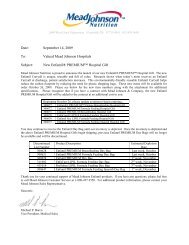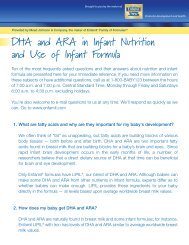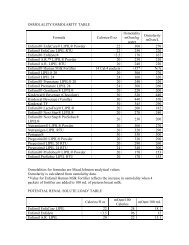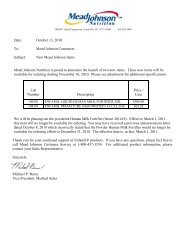LB2882MaternalNutriti+ - Mead Johnson Nutrition
LB2882MaternalNutriti+ - Mead Johnson Nutrition
LB2882MaternalNutriti+ - Mead Johnson Nutrition
Create successful ePaper yourself
Turn your PDF publications into a flip-book with our unique Google optimized e-Paper software.
Nutrient Needs during Pregnancy and Lactation<br />
A balanced diet that supports appropriate maternal weight gain and meets maternal and fetal nutrient needs<br />
contributes to creating a favorable intrauterine environment. 5 However, for a variety of reasons, pregnant and<br />
lactating women often do not consume the recommended amounts of essential nutrients. Inadequate micronutrient<br />
intake during pregnancy and lactation has been attributed to factors such as increased nutritional needs, maternal<br />
age, geography, and socioeconomic status. 21,65<br />
In the following sections, recommended intakes for energy, macro- and micronutrients during pregnancy and<br />
lactation are summarized.<br />
Energy<br />
The energy cost of pregnancy (measured in calories or kilojoules) includes energy needed for accretion of maternal,<br />
fetal and placental tissues, increases in the mother’s basal metabolism, and the mother’s physical activity level.<br />
Table 4 summarizes recommendations for additional daily calorie intakes during pregnancy and lactation. The FAO/<br />
WHO/UNU Expert Consultation on human energy requirements recommended an additional intake of 85, 285 and<br />
475 kcal/d during the first, second and third trimesters of pregnancy, respectively. 6 The IOM Dietary Reference<br />
Intakes do not recommend an increase in daily calorie intake during the first trimester of singleton pregnancies. 5<br />
Women are advised to increase their daily calorie intakes during pregnancy according to their pre-pregnancy body<br />
weight, physical activity level, and weeks gestation. The suggested calorie increase for women who conceive at a<br />
body weight in the normal range is 340 calories a day in the second trimester and 450 calories a day in the third<br />
trimester. 5 It has been suggested that in the US, women pregnant with multiple fetuses need about 500 calories a<br />
day beyond what is required for a singleton pregnancy starting in the first trimester. 66<br />
The amount of milk that a woman produces and secretes as well as the milk’s energy content influence the energy<br />
cost of lactation. 67 The FAO/WHO/UNU Expert Consultation on human energy requirements recommended<br />
that well-nourished lactating women consume an additional 505 kcal/d during the first 6 months of lactation.<br />
Undernourished women should consume more: an additional 675 kcal/d. The expert consultation did not make<br />
recommendations for the second 6 months of lactation since milk production is more highly variable during this<br />
time. 67 The IOM daily calorie intake recommendations for lactating women are based on pre-pregnancy calorie<br />
requirements for weight maintenance for women within the normal weight range. The IOM recommends that women<br />
in the normal weight range consume 330 additional calories per day for the first six months after delivery and 400<br />
additional calories each day for months six through 12 of their infant’s life. 5 Overweight and obese women and<br />
women who gained too much weight during pregnancy may not need to consume additional energy. Research<br />
indicates that once lactation is established, breastfeeding women with a post-pregnancy BMI >25 may restrict their<br />
intake by 500 kilocalories per day and exercise to promote weight loss without affecting infant growth. 27,68<br />
9

















